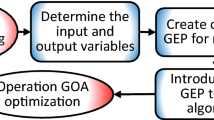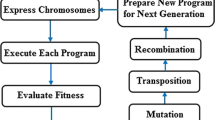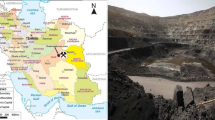Abstract
During blasting operations in open pit mines, most of the blast energy (approximately 40%) is wasted due to ground vibration. This phenomenon causes damages to the surrounding structures and pit slope. Therefore, prediction of ground vibration with an appropriate degree of accuracy is important to identify safety area of blasting. In this paper, in the first step, a predictive equation based on gene expression programming (GEP) was developed to estimate ground vibrations of blasting operations conducted in Gol-E-Gohar iron mine. For this aim, 115 blasting operations were identified and the most effective parameters on peak particle velocity (PPV), i.e., burden, spacing, stemming, hole-depth, hole-diameter, powder factor, maximum charge per delay and distance from the blast face were collected from the mine. Capability of the developed GEP model was compared with a non-linear multiple regression (NLMR) model and five conventional equations. The obtained results revealed that the developed GEP model is more efficient compared to the other models in predicting PPV. In the second step, to optimize the GEP predictive model, cuckoo optimization algorithm (COA) was employed and proposed. To do this, several strategies were defined and then several optimized blasting patterns were determined for each strategy. It was found that by developing the COA model, a significant reduction can be happened in PPV values.















Similar content being viewed by others
References
Bhandari S (1997) Engineering rock blasting operations. Taylor & Francis, Boca Raton
Singh J, Verma AK, Banka H, Singh TN, Maheshwar S (2016) A study of soft computing models for prediction of longitudinal wave velocity. Arabian J Geosci 9(3):1–11
Verma AK, Singh TN (2011) Intelligent systems for ground vibration measurement: a comparative study. Eng Comput 27:225–233
Lopez JC, Lopez JE (1995) Drilling and blasting of rocks. AA Balkema, Rotterdam
Singh TN, Singh R, Singh B, Sharma LK, Singh R, Ansari MK (2016) Investigations and stability analyses of Malin village landslide of Pune district, Maharashtra, India. Natl Hazards Online. doi:10.1007/s11069-016-2241-0
Sharma LK, Umrao RK, Singh R, Ahmad M, Singh TN (2016) Geotechnical characterization of road cut hill slope forming unconsolidated geo-materials: a case study, Geotech Geol Eng. doi:10.1007/s10706-016-0093-8
Yonghun J, Chungin L (2002) Application of neural networks to prediction of powder factor and peak particle velocity in tunnel blasting. Int Soc Explos Eng 2:67–76
Monjezi M, Baghestani M, Faradonbeh RS, Saghand MP, Armaghani DJ (2016) Modification and prediction of blast-induced ground vibrations based on both empirical and computational techniques. Eng Comput 32:717–728. doi:10.1007/s00366-016-0448-z
Wyllie DC, Mah C (2004) Rock slope engineering. Taylor & Francis, London
Gokhale BV (2010) Rotary drilling and blasting in large surface mines. CRC Press, Boca Raton
Khandelwal M, Armaghani DJ, Faradonbeh RS, Yellishetty M, Majid MZA, Monjezi M (2016) Classification and regression tree technique in estimating peak particle velocity caused by blasting. Eng Comput. doi:10.1007/s00366-016-0455-0
New BM (1986) Ground vibration caused by civil engineering works. Transport and Road Research Laboratory Research Report. No. RR 53
Bureau of Indian Standard (1973) Criteria for safety and design of structures subjected to underground blast ISI Bull IS-6922
Verma AK, Singh TN (2012) Comparative analysis of intelligent algorithms to correlate strength and petrographic properties of some schistose rocks. Eng Comput 28(1):1–12
Iphar M, Yavuz M, Ak H (2008) Prediction of ground vibrations resulting from the blasting operations in an open-pit mine by adaptive neurofuzzy inference system. Environ Geol 56:97–107
Singh TN, Singh V (2005) An intelligent approach to prediction and control ground vibration in mines. Geotech Geol Eng 23:249–262
Duvall WI, Petkof B (1959) Spherical propagation of explosion of generated strain pulses in rocks. USBM, RI-5483
Davies B, Farmer IW, Attewell PB (1964) Ground vibrations from shallow sub-surface blasts. Engineer 217:553–559
Ambrasey NR, Hendron AJ (1968) Dynamic behavior of rock masses. In: Stagg KG, Zienkiewicz OC (eds) Rock mechanics in engineering practices. Wiley, New York, pp 203–207
Langefors U, Kihlstrom B (1973) The modern technique of rock blasting, Second edn. Wiley, New York, p 405
Criteria for Safety and Design of Structures Subjected to Underground Blast (1973) Indian Standards Institute. ISI Bulletin IS-6922
Roy PP (1993) Putting ground vibration predictors into practice. Colliery Guard 241:63–67
Singh TN, Verma AK (2010) Sensitivity of total charge and maximum charge per delay on ground vibration. Geomat Natl Hazards Risk 1(3):259–272
Sharma LK, Singh R, Umrao RK, Sharma KM, Singh TN (2016) Evaluating the modulus of elasticity of soil using soft computing system. Eng Comput. doi:10.1007/s00366-016-0486-6
Shirani Faradonbeh R, Armaghani DJ, Majid MA, Tahir MM, Murlidhar BR, Monjezi M, Wong HM (2016) Prediction of ground vibration due to quarry blasting based on gene expression programming: a new model for peak particle velocity prediction. Int J Environ Sci Technol 13(6):1453–1464
Hasanipanah M, Monjezi M, Shahnazar A, Armaghani DJ, Farazmand A (2015) Feasibility of indirect determination of blast induced ground vibration based on support vector machine. Measurement 75:289–297
Khandelwal M, Singh TN (2009) Prediction of blasting induced ground vibration using artificial neural network. Int J Rock Mech Min Sci 46:1214–1222
Mohamed MT (2011) Performance of fuzzy logic and artificial neural network in prediction of ground and air vibrations. Int J Rock Mech Min Sci 48:845–851
Verma AK, Maheshwar S (2014) Comparative study of intelligent prediction models for pressure wave velocity. J Geosci Geomat 2(3):130–138
Mollahasani A, Alavi AH, Gandomi AH (2011) Empirical modeling of plate load test moduli of soil via gene expression programming. Comput Geotech 38(2):281–286
Yang Y et al (2013) A new approach for predicting and collaborative evaluating the cutting force in face milling based on gene expression programming. J Netw Comput Appl 36(6):1540–1550
Yassin MA, Alazba A, Mattar MA (2016) Artificial neural networks versus gene expression programming for estimating reference evapotranspiration in arid climate. Agric Water Manag 163:110–124
Ozbek A, Unsal M, Dikec A (2013) Estimating uniaxial compressive strength of rocks using genetic expression programming. J Rock Mech Geotech Eng 5(4):325–329
Çanakcı H, Baykasoğlu A, Güllü H (2009) Prediction of compressive and tensile strength of Gaziantep basalts via neural networks and gene expression programming. Neural Comput Appl 18(8):1031–1041
Dindarloo SR, Siami-Irdemoosa E (2015) Estimating the unconfined compressive strength of carbonate rocks using gene expression programming. Eur J Sci Res 135(3):309–316
Ahangari K, Moeinossadat SR, Behnia D (2015) Estimation of tunnelling-induced settlement by modern intelligent methods. Soils Found 55(4):737–748
Khandelwal M, Armaghani DJ, Faradonbeh RS, Ranjith PG, Ghoraba S (2016) A new model based on gene expression programming to estimate air flow in a single rock joint. Environ Earth Sci 75(9):1–13
Dindarloo SR (2015) Peak particle velocity prediction using support vector machines: a surface blasting case study. J South Afr Inst Min Metall 115(7):637–643
Holland JH (1975) Adaptation in natural and artificial systems: an introductory analysis with applications to biology, control, and artificial intelligence. University of Michigan Press, Ann Arbor (second edition: MIT Press, 1992)
Koza JR. Genetic programming: on the programming of computers by means of natural selection. MIT Press, Cambridge
Ferreira C (2001) Gene expression programming: a new adaptive algorithm for solving problems. Complex Syst 13(2):87–129
Teodorescu L, Sherwood D (2008) High energy physics event selection with gene expression programming. Comput Phys Commun 178:409–419
Khandelwal M, Faradonbeh RS, Monjezi M, Armaghani DJ, Majid, M.Z.B.A., Yagiz S (2016) Function development for appraising brittleness of intact rocks using genetic programming and non-linear multiple regression models. Eng Comput. doi:10.1007/s00366-016-0452-3
Ferreira C (2006) Gene expression programming: mathematical modeling by an artificial intelligence, 2nd edn. Springer, Germany (478 pp)
Güllü H (2012) Prediction of peak ground acceleration by genetic expression programming and regression: a comparison using likelihood-based measure. Eng Geol 141:92–113
Kayadelen C (2011) Soil liquefaction modeling by genetic expression programming and neuro-fuzzy. Expert Syst Appl 38:4080–4087
Rajabioun R (2011) Cuckoo optimization algorithm. Appl Soft Comput 11(8):5508–5518
Balochian S, Ebrahimi E (2013) Parameter optimization via cuckoo optimization algorithm of fuzzy controller for liquid level control. J Eng 2013:1–7
Kaydani H, Mohebbi A (2013) A comparison study of using optimization algorithms and artificial neural networks for predicting permeability. J Petrol Sci Eng 112:17–23
Mellal MA, Adjerida S, Williamsb EJ (2013) Optimal selection of obsolete tools in manufacturing systems using cuckoo optimization algorithm. Chem Eng 33:355–360
Ghasemi E, Ataei M, Hashemolhosseini H (2013) Development of a fuzzy model for predicting ground vibration caused by rock blasting in surface mining. J Vib Control 19(5):755–770
Jahed Armaghani D, Hajihassani M, Mohamad ET, Marto A, Noorani SA (2014) Blasting-induced flyrock and ground vibration prediction through an expert artificial neural network based on particle swarm optimization. Arab J Geosci 7(12):5383–5396
Hajihassani M, Jahed Armaghani D, Monjezi M, Mohamad ET, Marto A (2015) Blast-induced air and ground vibration prediction: a particle swarm optimization-based artificial neural network approach. Environ Earth Sci 74:2799–2817
Hajihassani M, Jahed Armaghani D, Marto A, Tonnizam Mohamad E (2015) Ground vibration prediction in quarry blasting through an artificial neural network optimized by imperialist competitive algorithm. Bull Eng Geol Environ 74:873–886
Monjezi M, Ghafurikalajahi M, Bahrami A (2011) Prediction of blast-induced ground vibration using artificial neural networks. Tunn Undergr Space Technol 26:46–50
Middleton GV (2000) Data analysis in the earth sciences using MATLAB®. Prentice Hall, USA
Tiryaki B (2008) Predicting intact rock strength for mechanical excavation using multivariate statistics, artificial neural networks, and regression trees. Eng Geol 99(1):51–60
https://help.xlstat.com/customer/en/portal/articles/2062047. Accessed July 2016
Sayadi AR, Khalesi MR, Borji MK (2014) A parametric cost model for mineral grinding mills. Miner Eng 55:96–102
Sayadi AR, Lashgari A, Paraszczak JJ (2012) Hard-rock LHD cost estimation using single and multiple regressions based on principal component analysis. Tunn Undergr Space Technol 27(1):133–141
Kaiser HF (1974) An index of factorial simplicity. Psychometrika 39(1):31–36
GEPSOFT (2006) GeneXproTools. Version 4.0, http://www.gepsoft.com/. Accessed July 2016
Faradonbeh RS, Armaghani DJ, Monjezi M (2016) Development of a new model for predicting flyrock distance in quarry blasting: a genetic programming technique. Bull Eng Geol Environ. doi:10.1007/s10064-016-0872-8
Tripathy A, Singh TN, Kundu J (2015) Prediction of abrasiveness index of some Indian rocks using soft computing methods. Measurement 68:302–309.
Liang M, Mohamad ET, Faradonbeh RS, Armaghani DJ, Ghoraba S (2016) Rock strength assessment based on regression tree technique. Eng Comput 32(2):343–354
Kamari A, Arabloo M, Shokrollahi A, Gharagheizi F, Mohammadi A (2015) Rapid method to estimate the minimum miscibility pressure (MMP) in live reservoir oil systems during CO2 flooding. Fuel 153:310–319
Hosseinzadeh M, Hemmati Sarapardeh A (2014) Toward a predictive model for estimating viscosity of ternary mixtures containing ionic liquids. J Mol Liq 200:340–348
Chen G, Fu K, Liang Z, Sema T, Li C, Tontiwachwuthikul P, Idem R (2014) The genetic algorithm based back propagation neural network for MMP prediction in CO 2-EOR process. Fuel 126:202–212
Konya CJ, Walter EJ (1990) Surface blast design. Prentice-Hall, USA
Hudaverdi T (2012) Application of multivariate analysis for prediction of blast-induced ground vibrations. Soil Dynam Earthq Eng 43:300–308
Hudaverdi T, Kuzu C, Fisne A (2012) Investigation of the blast fragmentation using the mean fragment size and fragmentation index. Int J Rock Mech Min Sci 56:136–145
Ash RL (1963) The mechanics of the rock breakage (part 1). Pit Quarry 56(2):98–100
Roy PP (2005) Rock blasting: effects and operations. CRC, London
Acknowledgements
The authors would like to extend their gratitude to Gol-E-Gohar iron mine management for his appreciable cooperation in measuring field data.
Author information
Authors and Affiliations
Corresponding author
Rights and permissions
About this article
Cite this article
Faradonbeh, R.S., Monjezi, M. Prediction and minimization of blast-induced ground vibration using two robust meta-heuristic algorithms. Engineering with Computers 33, 835–851 (2017). https://doi.org/10.1007/s00366-017-0501-6
Received:
Accepted:
Published:
Issue Date:
DOI: https://doi.org/10.1007/s00366-017-0501-6




